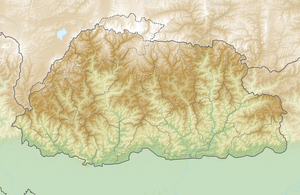Kula Kangri
| Kula Kangri (main peak) | ||
|---|---|---|
|
Kula Kagri in the background. Photo from 1933. |
||
| height | 7538 m | |
| location | Bhutan / Tibet border | |
| Mountains | Himalayas | |
| Dominance | 25.41 km → Gangkhar Puensum | |
| Notch height | 1654 m ↓ (5884 m) | |
| Coordinates | 28 ° 13 '36 " N , 90 ° 36' 58" E | |
|
|
||
| First ascent | April 21, 1986 by C. Itani, J. Sakamoto, H. Ozaki and E. Ohtani (Japan) | |
| particularities | Disagreement about nationality between China and Bhutan | |
The Kula Kangri is a 7538 m high mountain on the border between Bhutan and Tibet (PR China).
It was first climbed in 1986 by a Japanese expedition led by Kazumasa Hira. Sometimes the year 1937 is also given as the year of the first ascent, when the two climbers Freddie Spencer Chapman and Pasang Dawa Lama are said to have climbed the summit from Bhutan over the southeast spur as part of a British expedition.
In addition to the main peak located in the west of the mountain range on the international border, the Kula Kangri also has a central peak ( 7418 m , ⊙ ) and an eastern peak ( 7381 m , ⊙ ), both of which are located on Tibetan territory.
Highest mountain in Bhutan
The Kula Kangri has long been considered the highest mountain in Bhutan. However, there is disagreement about the exact border line between Bhutan and China. Therefore, there are also maps on which the Kula Kangri is noted as a mountain in Tibet. According to this definition, Gangkhar Puensum, a little south, would be the highest mountain in Bhutan. In the ancient system of four of the sacred mountains of Tibetan antiquity, the Kula Kangri occupies the southern position. For the local population in Lhozhag in southern Tibet , it is still the residence of the local patron deity and therefore of sacred importance.
Height indication
The determination of the summit height of Kula Kangri was carried out through several expeditions, later also by the Chinese military. That is why there are various information about the height of Kula Kangri, including the altitude of 7538 m on military maps. In addition, there is also the altitude indication 7554 m , which corresponds to the measurements of the Swiss geologist Günter Dyhrenfurth , who determined the heights of the Kula Kangri and the Gangkhar Puensum during an expedition.
literature
- Blanche-Christine Olschak et al .: Himalaya. Growing mountains, living myths, wandering people . vgs, Cologne 1987. ISBN 3-8025-2174-9
- Andreas Gruschke : The holy places of the Tibetans. Myths and legends from Kailash to Shambhala . Diederichs Verlag, Munich 1997, pp. 41-42, 88, 239-240. ISBN 3-424-01377-3
Web links
- Article about the discussion about the height determination of Kula Kangri, in English
- The holy mountain Kula Kangri
- Satellite image of the Kula Kangri (Google Maps)
- Kula Kangri on Peakbagger.com (English)
- Kula Kangri at Peakware (English)
- Photo at summitpost.org
Individual evidence
- ↑ Kazumasa Hirai: The Ascent of Kula Kangri from Tibet. In: Himalayan Journal Vol. 43, 1987. The Himalayan Club, accessed February 20, 2017 .
- ↑ Eberhard Jurgalski: High Asia - All mountains and main peaks above 6750 m (list of all mountains in Asia with a height of more than 6750 meters) at www.8000ers.com, as of June 10, 2013 , accessed on July 3, 2013.
- ^ Website of the Alpine Club of Kobe
- ↑ Mountain list with the Kula Kangri on www.8000ers.com
- ↑ Punsum and Kula Kangri. Discussion and collection of material on the border between Bhutan and Tibet. viewfinder, archived from the original on September 12, 2013 ; accessed on February 16, 2017 .
- ↑ Sources: Internet; Gruschke: The Holy Places of the Tibetans, 1997, p. 239f .; Olschak et al. a., Himalaya, vgs

